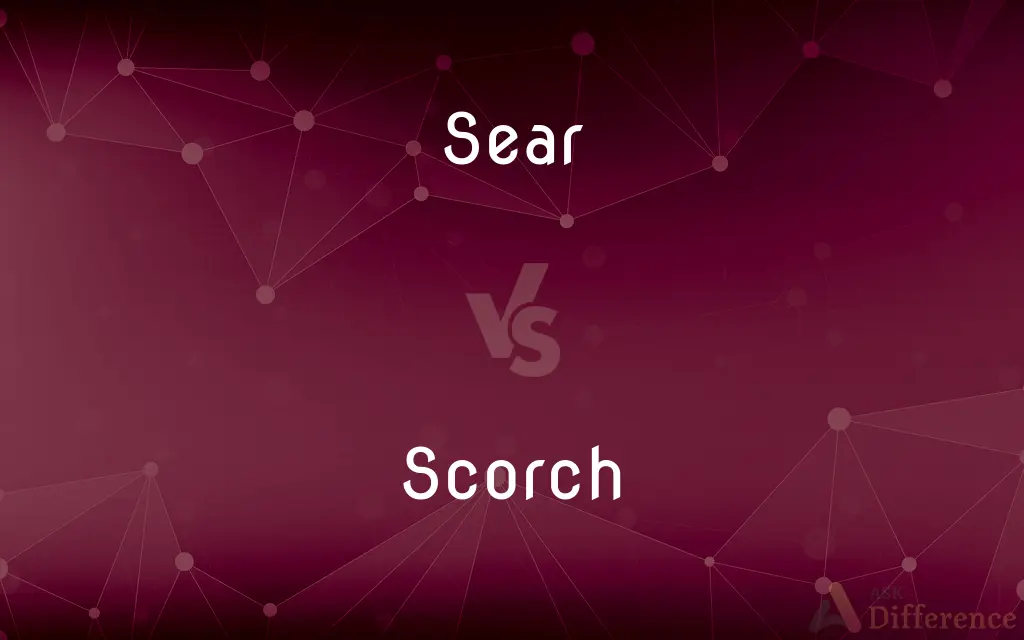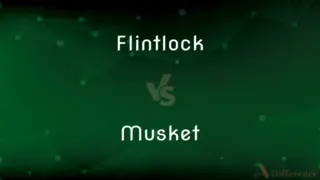Sear vs. Scorch — What's the Difference?
By Tayyaba Rehman & Maham Liaqat — Updated on April 1, 2024
Searing involves browning the surface of food at high temperature, enhancing flavor; scorching involves burning slightly, often leading to discoloration and a change in taste.

Difference Between Sear and Scorch
Table of Contents
ADVERTISEMENT
Key Differences
Searing and scorching are both cooking methods involving high heat, but they differ in intention and outcome. Searing is a technique used primarily to add flavor and color to the surface of food, such as meats, by cooking it at a high temperature until a browned crust forms. This method is often used as a preliminary step in cooking, aiming to seal in the juices and enhance the taste of the dish. On the other hand, scorching usually refers to burning or browning food or an object to a degree that is often undesirable. Scorching can occur when food is left too long on a high heat without movement, leading to a burnt flavor and a darkened, sometimes crisp texture.
While searing is considered a culinary technique that can enhance the flavor profile of a dish, scorching is typically seen as a cooking mishap that can result in a bitter taste and an unappealing appearance. The intent behind searing is to create a Maillard reaction, a chemical reaction between amino acids and reducing sugars that gives browned food its distinctive flavor. Whereas, scorching happens when the food exceeds the desired temperature for searing, causing parts of it to burn.
Temperature control plays a crucial role in differentiating between searing and scorching. Searing requires a very high heat to quickly brown the surface of the food without cooking it through, typically using a skillet or a grill. In contrast, scorching occurs when the heat is too high for too long, leading to the degradation of food quality.
The equipment used can also affect the outcome between searing and scorching. For searing, heavy-bottomed pans or cast-iron skillets are preferred as they can withstand high temperatures and distribute heat evenly. Meanwhile, thin pans or high heat without proper utensil can easily lead to scorching, as they are less forgiving and can cause uneven heating and burning.
While searing and scorching both use high heat, their outcomes are vastly different. Searing is a controlled process that enhances flavor, while scorching is an accidental burning that detracts from the food's quality.
ADVERTISEMENT
Comparison Chart
Purpose
To brown the surface for flavor and appearance.
To burn or discolor due to excessive heat.
Outcome
Enhances flavor with a browned crust.
Leads to a bitter taste and possible damage.
Technique
High heat for a short duration.
High heat for too long or unattended cooking.
Temperature
Very high but controlled.
Often uncontrolled and excessively high.
Equipment
Heavy-bottomed pans or grills preferred.
Can occur with any cookware, often due to mishandling.
Compare with Definitions
Sear
Causes chemical reactions for browning.
Searing produced a flavorful Maillard reaction on the surface.
Scorch
Burning food slightly by exposing it to too much heat.
The bread was scorched after being left in the oven too long.
Sear
Searing meat locks in juices and enhances its flavor.
She seared the chicken to enrich its taste.
Scorch
Typically results from unattended cooking.
The rice scorched when she forgot to turn down the heat.
Sear
A technique involving very high temperatures.
Searing requires a hot pan to achieve the right crust.
Scorch
Leads to unwanted dark spots or areas.
Scorching the milk caused a skin to form on top.
Sear
Often the first step in cooking meats.
Searing the roast beef before slow cooking improves its flavor.
Scorch
Overheating food can make it taste bitter.
The scorched vegetables had a bitter flavor.
Sear
A cooking method that quickly browns the surface of food at high heat.
Searing the steak formed a delicious crust.
Scorch
Excessive heat can harm pans.
The high flame scorched the bottom of the pot.
Sear
To char, scorch, or burn the surface of.
Scorch
To burn superficially so as to discolor or damage the texture of.
Sear
To brown (meat) quickly using very high heat. ]
Scorch
A slight or surface burn.
Sear
Variant of sere1.
Scorch
A discolouration caused by heat.
Sear
Dry; withered, especially of vegetation.
Scorch
(phytopathology) Brown discoloration on the leaves of plants caused by heat, lack of water or by fungi.
Sear
(transitive) To char, scorch, or burn the surface of (something) with a hot instrument.
Scorch
(transitive) To burn the surface of something so as to discolour it
Sear
To wither; to dry up.
Scorch
(transitive) To wither, parch or destroy something by heat or fire, especially to make land or buildings unusable to an enemy
Sear
To make callous or insensible.
Scorch
(ergative) (To cause) to become scorched or singed
Sear
To mark permanently, as if by burning.
The events of that day were seared into her memory.
Scorch
(intransitive) To move at high speed (so as to leave scorch marks on the ground, physically or figuratively).
Sear
A scar produced by searing
Scorch
To burn; to destroy by, or as by, fire.
Sear
Part of a gun that retards the hammer until the trigger is pulled.
Scorch
(transitive) To attack with bitter sarcasm or virulence.
Sear
Dry; withered; no longer green; - applied to leaves.
I have lived long enough; my way of lifeIs fall'n into the sear, the yellow leaf.
Scorch
To ride a bicycle furiously on a public highway.
Sear
To wither; to dry up.
Scorch
To burn superficially; to parch, or shrivel, the surface of, by heat; to subject to so much heat as changes color and texture without consuming; as, to scorch linen.
Summer drouth or singèd airNever scorch thy tresses fair.
Sear
To burn (the surface of) to dryness and hardness; to cauterize; to expose to a degree of heat such as changes the color or the hardness and texture of the surface; to scorch; to make callous; as, to sear the skin or flesh. Also used figuratively.
I'm seared with burning steel.
It was in vain that the amiable divine tried to give salutary pain to that seared conscience.
The discipline of war, being a discipline in destruction of life, is a discipline in callousness. Whatever sympathies exist are seared.
Scorch
To affect painfully with heat, or as with heat; to dry up with heat; to affect as by heat.
Lashed by mad rage, and scorched by brutal fires.
Sear
The catch in a gunlock by which the hammer is held cocked or half cocked.
Scorch
To burn; to destroy by, or as by, fire.
Power was given unto him to scorch men with fire.
The fire that scorches me to death.
Sear
Make very hot and dry;
The heat scorched the countryside
Scorch
To be burnt on the surface; to be parched; to be dried up.
Scatter a little mungy straw or fern amongst your seedlings, to prevent the roots from scorching.
Sear
Become superficially burned;
My eyebrows singed when I bent over the flames
Scorch
To burn or be burnt.
He laid his long forefinger on the scarlet letter, which forthwith seemed to scorch into Hester's breast, as if it had been red hot.
Sear
Cause to wither or parch from exposure to heat;
The sun parched the earth
Scorch
To ride or drive at great, usually at excessive, speed; - applied chiefly to automobilists and bicyclists. [Colloq.]
Sear
(used especially of vegetation) having lost all moisture;
Dried-up grass
The desert was edged with sere vegetation
Shriveled leaves on the unwatered seedlings
Withered vines
Scorch
A surface burn
Scorch
A plant disease that produces a browning or scorched appearance of plant tissues
Scorch
A discoloration caused by heat
Scorch
Make very hot and dry;
The heat scorched the countryside
Scorch
Become superficially burned;
My eyebrows singed when I bent over the flames
Scorch
Destroy completely by or as if by fire;
The wildfire scorched the forest and several homes
The invaders scorched the land
Scorch
Burn slightly and superficially so as to affect color;
The cook blackened the chicken breast
The fire charred the ceiling above the mantelpiece
The flames scorched the ceiling
Scorch
Become scorched or singed under intense heat or dry conditions;
The exposed tree scorched in the hot sun
Common Curiosities
What is searing in cooking?
Searing is a technique used to brown the surface of food at high heat, enhancing its flavor and appearance.
What's the main difference between searing and scorching?
The main difference is intent and outcome; searing enhances flavor, while scorching indicates burning and is often unintentional.
What happens if you scorch a pan?
Scorched pans can become discolored and might retain flavors of burned food, potentially affecting future dishes.
Can all foods be seared?
While many foods benefit from searing, especially meats, not all foods are suited for this high-heat method.
Why do chefs sear meat before cooking it?
Chefs sear meat to lock in juices and create a flavorful browned crust through the Maillard reaction.
Can searing make food taste better?
Yes, searing can significantly enhance the taste of food by developing complex flavors and aromas.
How can I prevent scorching while cooking?
Prevent scorching by using appropriate heat settings, stirring frequently, and using heavy-bottomed cookware.
What does it mean to scorch food?
Scorching food means burning it slightly, often leading to undesirable flavors and discoloration.
Is scorching ever a desired cooking technique?
Typically, scorching is not desired as it indicates excessive heat and can ruin the taste and appearance of food.
How do you fix scorched food?
If only slightly scorched, removing the burnt parts might salvage the dish; however, severely scorched food is often inedible.
What's the best pan for searing?
Heavy-bottomed pans and cast-iron skillets are best for searing because they retain high heat and distribute it evenly.
Share Your Discovery

Previous Comparison
Flintlock vs. Musket
Next Comparison
Evangelical vs. ProtestantAuthor Spotlight
Written by
Tayyaba RehmanTayyaba Rehman is a distinguished writer, currently serving as a primary contributor to askdifference.com. As a researcher in semantics and etymology, Tayyaba's passion for the complexity of languages and their distinctions has found a perfect home on the platform. Tayyaba delves into the intricacies of language, distinguishing between commonly confused words and phrases, thereby providing clarity for readers worldwide.
Co-written by
Maham Liaqat















































